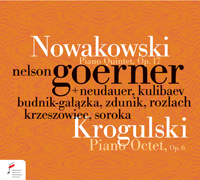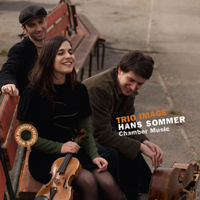Shostakovich/Barshai: Chbr Syms 2 & 3 (tr Barshai of Stg Qts 10 & 3); Yablonsky/Kiev Virtuosi [Naxos]
Shostakovich/Barshai: Chbr Syms 1, 4 & 5 (tr Barshai of Stg Qts 8, 4 & 1); Yablonsky/Kiev Virtuosi [Naxos]
Generally speaking, Russian composer Dmitri Shostakovich's (
1906-1975) fifteen string quartets (
1935-74) are intimate expressions of the composer's most private thoughts during a period of great political and cultural upheaval in his country, particularly when it was known as the Soviet Union (
1922-91). Then between 1960 and 1995 his countryman violist-conductor Rudolf Barshai (
1924-2010) transcribed five of them, keeping their same movement layout, into what he called "Chamber Symphonies". The order in which his arrangements followed one another differs from that of the parent works, and their scoring varies as indicated in the table below:
|
- SHOSTAKOVICH/BARSHAI: "CHAMBER SYMPHONIES" -
|
BARSHAI
"CHAMBER SYMPHONY"
|
SHOSTAKOVICH
PARENT QUARTET
|
|
NUMBER
|
SCORING
|
OPUS
|
YEAR
|
NUMBER
|
OPUS
|
YEAR
|
|
1
|
Strings
|
110a
|
1960
|
8
|
110
|
1960
|
|
2
|
Strings
|
118a
|
1965
|
10
|
118
|
1964
|
|
3
|
Woodwinds, Harp, Celeste & Strings
|
73a
|
1990
|
3
|
73
|
1946
|
|
4
|
Chamber Orchestra
|
83a
|
1990
|
4
|
83
|
1949
|
|
5
|
Celeste & Strings
|
49a
|
1995
|
1
|
49
|
1938
|
Barshai was well qualified to do this as he'd played viola with the
Borodin Quartet from 1945 until 1953, and in 1955 became the founding conductor of the world-renowned Moscow Chamber Orchestra (MCO). He'd hold that post for almost twenty years, during which he’d develop a close association and friendship with Shostakovich. Then Russian anti-Semitism reputedly forced him to abandon his MCO post in 1977, and emigrate west, where he took other conducting assignments.
Backing up a bit, around 1960 he worked Prokofiev's (1891-1953) biting piano pieces known collectively as
Visions fugitives (
Fleeting Visions,
1915-7) into a highly acclaimed chamber
transcription. Spurred on by the popularity of this arrangement, Rudolf then got Dmitri's permission to orchestrate his eighth string quartet (
Op. 110, 1960).
This was such a great success, the composer wrote him, suggesting he should consider doing more of them. Consequently, he came up with another four “Chamber Symphonies” that along with the first are consummate, virtuosically demanding arrangements. All five have a textural variety and increased dynamic range, which give them even greater emotional impact than the parent quartets, but without leaving Dmitri's sound world.
Three of them, namely the first, fourth and fifth, are on the Naxos CD pictured to the right [DR]. This disc came out over a year ago, and has already received glowing reports from several readily available sources. Accordingly, we'll keep our comments to a minimum.
Appropriately enough Barshai's initial effort (1960 for strings after
Quartet No. 8, Op. 110, 1960) starts with a
largo [DR, T-5] and the notes D-Eb-C-B [00:00], or "D-S-C-H" in German notation, which is a musical monogram (MM) Shostakovich frequently used (see
30 September 2012). MM reappears throughout the piece, and there are also many other thematic teasers from works of his predating the parent quartet. For a more detailed listing of them click
here.
Returning to the
largo [DR, T-5], it's the first of five conjoined movements, and takes the form of a despondent lament. This is offset by an infectious, antic
allegro [DR, T-6], which has those combative driving motifs that are one of Shostakovich's most distinguishing stylistic traits. These include MM (beginning at 00:30], a whinnying version of which [DR, T-7, 00:00] foals a sardonic
allegretto followed by two concluding
largos.
The first of the latter begins with a
forte three-note riff (FT) [DR, T-8, 00:00] that's repeated, and soon followed by a despondent, FT-riddled passage [00:51]. The music becomes increasingly wistful, and then the return of FT [04:43] and MM [04:48] initiate the final
largo [DR, T-9, 00:02]. This is an MM-riddled elegy that ends the work with a feeling of hopeless resignation. Dmitri must have really been bummed out when he wrote the parent quartet!
Five years later Barshai came up with a second "Chamber Symphony" (1965 aka "Symphony for Strings" after
Quartet No. 10, Op. 118, 1964), and it would be another twenty-five before he completed a third. These two fill the recently released Naxos disc pictured to the left [DL].
The earlier one is only in four movements with an opening
andante [DL, T-6] that's a giddy piece of work consisting of tiny, mercurial motivic tidbits. These are underlined by fragmented questioning ideas [00:15], which at one point make a spooky
sul ponticello appearance [03:41].
This pixilated music is completely offset by the following
allegretto furioso [DL, T-7] that’s a bellicose foray. Then peace is restored in the next
adagio [DL, T-8], which is a somber
passacaglia. This has sad lower strings intoning a lugubrious
ostinato (LR) [00:00], over which the upper ones play descants of consolation.
But to no avail as the movement ends with weeping passages for the would-be comforters. These bridge directly into the finale [DL, T-9] that starts with a cheery cantering ditty (CC) [00:00]. This is explored, and followed by a CC-related, flowing, folk-song-like (CF) melody [01:18]. The two ideas are then intertwined with arresting
pizzicato accents [02:23], and come to an agitated climax.
It falls away into the return of LR [07:03], bringing back memories of the previous
adagio. Then we get a short pause, and LR-derived solo passages [07:41] introduce a delicate concluding section, starting with the reappearance of CF [08:06] and CC [08:36]. There are also hints of ideas from the first movement [beginning at 09:50], thereby ending the work in the same spirit it began.
Moving ahead fifteen years we get the other selection on this disc, Barshai's third "Chamber Symphony" (1990 for woodwinds, harp, celeste & strings after
Quartet No. 10, Op. 118, 1964). In five movements, the opening
allegretto [DL, T-1] begins with an impish tripping tune for strings and harp (IT) [01:01]. It's followed by flute and oboe intoning a subdued, taunting countersubject (ST) [01:17].
Then IT initiates a capricious, development with contrapuntal
layering [02:22], after which ST [04:38] announces a curt recap. This sparks a frenetic IT-based coda [05:12] that ends this sonata form cavort with a sneeze!
The succeeding
moderato [DL, T-2] is a troubled intermezzo where a sawing bass line [00:00] underscores a flighty headstrong theme [00:02]. It alternates with a dismissive countersubject (DC) [02:09], and then a plangent woodwind reminder of DC [04:49] closes the movement despairingly.
Hostilities break out in the
allegro molto [DL, T-3], which is a pugnacious
scherzo that brings to mind Dmitri's war symphonies (Nos. 4-9,
1935-1945). Here rhythmically martial themes conjure up thoughts of
goose-stepping Nazis, and humongous
Stalin tanks on the move.
The next
adagio [DL, T-4] is another
passacaglia (see above), and opens with an ominous
ostinato (OO) that’s an ascending-descending motif for the strings [00:00] linked to a plangent oboe retort [00:20]. Then OO is repeated [00:54], but with a clarinet rejoinder, after which OO appears four more times to varying accompaniments. These range from apathetic [01:58] to grief-stricken [02:46 & 03:53], and finally resigned [04:30].
This movement bridges directly into the final
moderato [DL, T-5] that lasts about twice as long as any of the preceding ones. It opens with cellos and harp intoning an ambling, singsong theme (AS) [00:00], which is picked up by the winds [00:45]. AS is succeeded by a related longing melody (AL) played by the upper strings [01:40] that's set to a
pizzicato accompaniment. After that AS reappears [02:40] followed by a jolly, rustic bassoon tune (JR) [03:26], and JR is explored leading to the return of AS [05:01] and AL [06:12].
They fuel a highly agitated episode with a commanding reminder of OO [06:12] (see above) that falls away into a plaintive cello passage [06:53]. This is immediately followed by the return of JR in the high strings [07:26], which sashays about. It then slows into a tranquil reminder of AS [09:16] with some gentle harp strokes, concluding the work on a celestial note.
The earlier CD on the right is filled out with the last two "Chamber Symphonies", both of which are four-movement works. The penultimate fourth (1990 is for chamber orchestra after
Quartet No. 4, Op. 83, 1949), and the most colorfully scored of all five. Its opening
allegretto [DR, T-10] begins with a reflective thematic nexus (RT) played by the upper instruments [00:00] over a drone accompaniment from the lower ones. RT is subjected to a rhapsodic development having a brief dialogue for the winds [02:18-03:17], and then ends the movement peacefully in a nostalgic reminder of RT [04:01].
An
andantino [DR, T-11] follows, beginning with subdued, sighing strings [00:00] succeeded by a keening woodwind idea (KW) [00:05]. This undergoes a couple of variational explorations that are respectively tormented [01:38] and hopeful [03:31]. Then bits of KW return [04:32, 04:49 & 05:13] to end the movement with a hint of optimism.
Next there's an
allegro [DR, T-12] that's an aloof
scherzo. It opens whimsically, and has a Slavic folkish theme [00:51], which turns into a twirling episode [02:29]. The latter bridges via a sustained wind note into the final
allegretto [DR, T-13].
It starts with a relaxed nonchalant theme (RN) [00:03], and a brief fanfare [00:42] heralding a mischievous, agitated idea (MA) [00:47]. The two undergo a colorful dramatic development [01:51], after which forceful reminders of RN [05:22] and MA [05:31] begin a cheeky recapitulation with petulant whip snaps [06:28]. This winds down, and after a brief pause there’s an RN-reminiscent, laid-back coda [07:20] that ends the work in hushed anonymity.
The fifth and final "Chamber Symphony" (1995 for celeste & strings after
Quartet No. 1, Op. 49, 1938) starts with a
moderato [DR, T-1], having a sighing first theme [00:02] followed by a dramatic pleading idea (DP) [01:24] set to a jocular, hiccupping accompaniment. The two undergo a cursory, searching development [02:34], after which a DF-related, recap coda [04:09] ends the movement uneventfully.
It’s followed by another moderato [DR, T-2] that’s a theme and variations that starts with a dreamy, lullaby-like main subject (DL) [00:00]. The succeeding transformations include a winsome, celeste-gilded one [02:14], and then the movement ends in a
pizzicato-decorated DL [03:30] with a categorical final pluck.
The next
allegro molto [DR, T-3] is a
scherzo with airy outer sections. They surround a dainty, dancelike trio tune [00:49-01:49] that takes a brief bow towards the end [02:05].
In closing, we get an
allegro [DR, T-4], which begins with an angular skipping idea [00:00] complemented by a folkish sounding one [00:43]. They’re tossed about, and the work ends energetically bringing Rudolf's series of "Chamber Symphonies" to a rousing conclusion.
The Ukrainian National Chamber Ensemble known as the "Kiev Virtuosi" under their principal conductor, Dmitry Yablonsky, play this music to perfection. It's obvious from the many solos that these musicians are all virtuosos in their own right. That plus Naxos bargain prices, make these two discs the obvious choice for those wishing to acquire all five works.
The recordings were made in the National Radio of Ukraine Concert Hall, Kiev. Despite their being done on three separate occasions between 2014 and 2016, the sound is consistently good with maybe a hint of digital grain in the fourth "Chamber Symphony".
They project an ideally sized sonic image in enrichingly reverberant surroundings with all the instruments well placed and balanced. The overall timbre is lifelike with bright, pleasant highs, except as noted above, a musical midrange, and clean bass with no low string hangover. Twentieth century Russian music enthusiasts as well as any audiophiles among them won't want to be without these CDs.
--
Bob McQuiston, Classical Lost and Found (CLOFO.com, Y170528, Y170527)











